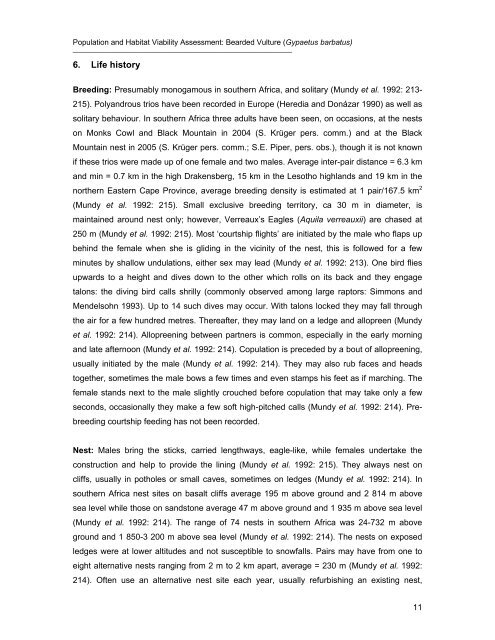BEARDED VULTURE POPULATION AND HABITAT VIABILITY ...
BEARDED VULTURE POPULATION AND HABITAT VIABILITY ...
BEARDED VULTURE POPULATION AND HABITAT VIABILITY ...
Create successful ePaper yourself
Turn your PDF publications into a flip-book with our unique Google optimized e-Paper software.
Population and Habitat Viability Assessment: Bearded Vulture (Gypaetus barbatus)<br />
________________________________________________<br />
6. Life history<br />
Breeding: Presumably monogamous in southern Africa, and solitary (Mundy et al. 1992: 213-<br />
215). Polyandrous trios have been recorded in Europe (Heredia and Donázar 1990) as well as<br />
solitary behaviour. In southern Africa three adults have been seen, on occasions, at the nests<br />
on Monks Cowl and Black Mountain in 2004 (S. Krüger pers. comm.) and at the Black<br />
Mountain nest in 2005 (S. Krüger pers. comm.; S.E. Piper, pers. obs.), though it is not known<br />
if these trios were made up of one female and two males. Average inter-pair distance = 6.3 km<br />
and min = 0.7 km in the high Drakensberg, 15 km in the Lesotho highlands and 19 km in the<br />
northern Eastern Cape Province, average breeding density is estimated at 1 pair/167.5 km 2<br />
(Mundy et al. 1992: 215). Small exclusive breeding territory, ca 30 m in diameter, is<br />
maintained around nest only; however, Verreaux’s Eagles (Aquila verreauxii) are chased at<br />
250 m (Mundy et al. 1992: 215). Most ‘courtship flights’ are initiated by the male who flaps up<br />
behind the female when she is gliding in the vicinity of the nest, this is followed for a few<br />
minutes by shallow undulations, either sex may lead (Mundy et al. 1992: 213). One bird flies<br />
upwards to a height and dives down to the other which rolls on its back and they engage<br />
talons: the diving bird calls shrilly (commonly observed among large raptors: Simmons and<br />
Mendelsohn 1993). Up to 14 such dives may occur. With talons locked they may fall through<br />
the air for a few hundred metres. Thereafter, they may land on a ledge and allopreen (Mundy<br />
et al. 1992: 214). Allopreening between partners is common, especially in the early morning<br />
and late afternoon (Mundy et al. 1992: 214). Copulation is preceded by a bout of allopreening,<br />
usually initiated by the male (Mundy et al. 1992: 214). They may also rub faces and heads<br />
together, sometimes the male bows a few times and even stamps his feet as if marching. The<br />
female stands next to the male slightly crouched before copulation that may take only a few<br />
seconds, occasionally they make a few soft high-pitched calls (Mundy et al. 1992: 214). Prebreeding<br />
courtship feeding has not been recorded.<br />
Nest: Males bring the sticks, carried lengthways, eagle-like, while females undertake the<br />
construction and help to provide the lining (Mundy et al. 1992: 215). They always nest on<br />
cliffs, usually in potholes or small caves, sometimes on ledges (Mundy et al. 1992: 214). In<br />
southern Africa nest sites on basalt cliffs average 195 m above ground and 2 814 m above<br />
sea level while those on sandstone average 47 m above ground and 1 935 m above sea level<br />
(Mundy et al. 1992: 214). The range of 74 nests in southern Africa was 24-732 m above<br />
ground and 1 850-3 200 m above sea level (Mundy et al. 1992: 214). The nests on exposed<br />
ledges were at lower altitudes and not susceptible to snowfalls. Pairs may have from one to<br />
eight alternative nests ranging from 2 m to 2 km apart, average = 230 m (Mundy et al. 1992:<br />
214). Often use an alternative nest site each year, usually refurbishing an existing nest,<br />
11


